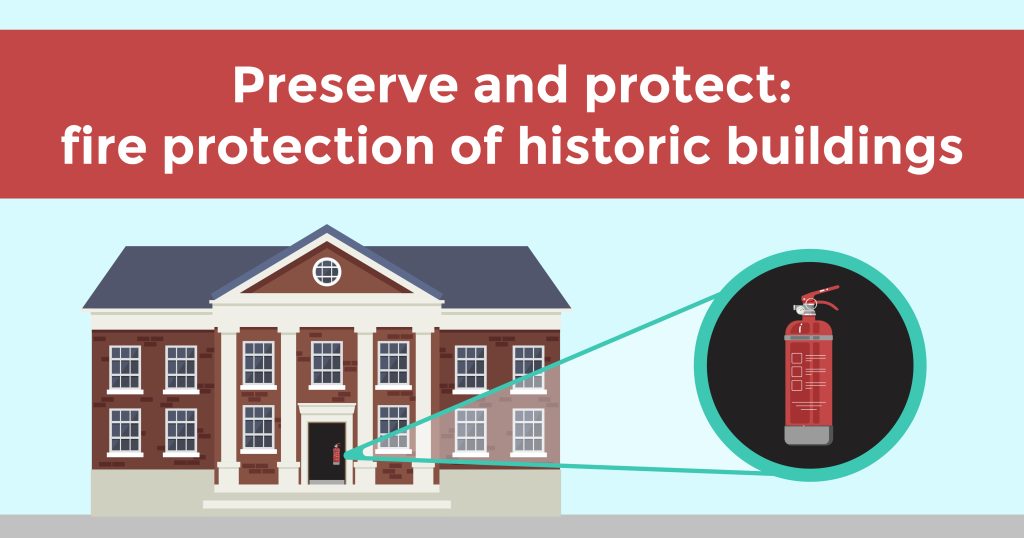Your basket is currently empty!
Preserve and Protect: Fire Safety For Historic Buildings
Fire safety is important for all buildings, with the Regulatory Reform (Fire Safety) Order 2005 (RRO), applying to all non-private buildings. This means all commercial properties are subject to the regulations, including historic buildings and listed buildings.
As you can imagine, fire safety for such buildings with historical importance – and where high-value, often priceless objects are kept – can look slightly different. It may also require the responsible person to factor in multiple additional, unconventional prevention and protection measures.
This month at Fire Safety Equipment, we’ll explore the different aspects of fire safety you’ll need to consider if you own or manage a historic building or listed building as commercial premises.

How do historic buildings differ from normal buildings?
Calling a building “historic” can mean a variety of things. It could be that the building structure itself holds heritage and importance, either due to age or its place in history, such as a castle or famous residence, or it could hold items of historic importance, such as museums and art galleries. Either way, this presents different challenges when compared to a standard building developed in more modern times.
While there isn’t a different set of regulations to cover these buildings – primarily because the RRO is extremely thorough already – a fire risk assessment will look a lot different to that of a standard, modern office building or retail space.
Common fire hazards in listed and heritage buildings
Some of the things that you should assess and pay special attention to within a heritage building might be obvious, while other aspects may require more thought. The following are just four common fire hazards in heritage and listed buildings to consider:
- Flammable items – Artefacts, including textiles and tapestries, along with works of art can present a fire risk in the form of flammable items. This can add fuel to fires and quicken the rate at which it spreads. For this reason, and due to the value or importance of the items, their positioning should be well thought out, away from sources of ignition, and appropriate suppression systems and protection equipment must be put in place.
- Complex floor plans – Due to their age, some historic buildings may not facilitate easy evacuation routes for emergencies. Staircases, split levels and long corridors are hard to adapt in listed buildings, so emergency lighting and direction in an emergency is crucial to guide people within such a building.
- Wiring and electrics – While it’s likely that most buildings in operation today will have relatively modern wiring and electrics, having been adapted at some point, there may still be outdated elements to the system. For this reason, regular PAT testing, along with inspections and maintenance of fuse boxes, should be carried out to avoid this triggering a fire.
- Signage and fire safety equipment – Due to the structure of certain buildings – both in terms of the materials to be preserved and the layout – special consideration needs to be given to the siting of things like fire extinguishers and fire signage. A fire risk assessment can help you obtain professional guidance on this.
Prevention measures
As always, prevention is the best approach when it comes to fire safety; if you can avoid fires in the first place, you can protect lives and your building. A fire risk assessment is one of the best tools to help you prevent fires, as it will include the following stages:
- The identification of fire hazards within your historic building
- The identification of any people at risk
- Measures to evaluate, remove or reduce the risks involved
- A record of the findings, with an emergency plan and training
- A regular review to ensure everything is up to date
We’ve already mentioned the importance of testing equipment and the positioning of flammables, but the prevention of arson is also important. Is your building at risk from this and is it secured out of operation hours? CCTV security equipment can be a good deterrent against this.
Covering all these facets of a historic building can ensure the risk of fire is kept at an absolute minimum.
Protection measures
After all steps to prevent a fire have been taken, it’s time to look at protection measures. This is something that can be difficult when it comes to heritage buildings, as the structure may not be conducive to common protection practices.
While altering the shape and structure of the building will be virtually impossible, there may be some practical options in the shape of new materials to satisfy fire resistance standards. For example, compartmentalisation may not be easy to achieve without the installation of additional fire doors that automatically close. You should consult expert fire safety contractors to assist you with this, as they will have the knowledge and understanding of building regulations and fire safety laws to secure your property.
In addition to the above, you should include fire safety equipment as part of your protection measures. This includes getting the right fire extinguishers, fire alarm system, riser system, hose reels and automatic suppression systems to suit your building. Additionally, systems that can reduce oxygen levels within unoccupied spaces can help to protect high-value items without the damage that water can create.
At Fire Safety Equipment, we supply a wide range of essential fire extinguishers, accessories and signage to help you protect your building — whether it’s a brand new development or a highly prestigious property that needs to be preserved. Browse our products online and help to keep both visitors and valuable property safe from fire.
You can get free, swift delivery on orders in the UK, with high-quality equipment supplied to meet all your needs.